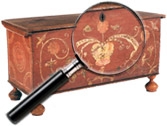|
|
Bakelite
Scandal & the Story of Bakelite Bakelite hit the market in 1907, heralding the arrival of the modern plastics industry. Bakelite was the first completely man made plastic, as until then, plastics such as celluloid, casein, and Gutta-Percha all had as a base a natural material. It was developed by Belgian-born chemist Dr. Leo Hendrick Baekeland who started his firm General Bakelite Company to produce the phenolic resin type plastic. Bakelite was inexpensive [...] Click here to continue reading.
Ormolu
Ormolu, an 18th-century English term, is from the French phrase or moulu, with “or” indicating gold and “moulu” being a form of an old French verb moudre, which means “to grind up.” (This French term for this technique is bronze dore.) This idea of “ground-up gold”refers to the production process of ormolu, where high-quality gold is finely powdered and added to a mercury mixture and applied to a bronze object. Modern usage often [...] Click here to continue reading.
Vermeil
“Vermeil” is a French word co-opted by the English in the 19th century for a silver gilt process. Vermeil is a combination of silver and gold, although other precious metals are also occasionally added, that is then gilded onto a sterling silver object. The reddish (vermilion) hue of the addition of the gold gives the product its name. Vermeil is commonly found in jewelry, and a standard of quality (10 karat gold) and [...] Click here to continue reading.
Baleen, Plastic of the 18th Century
Baleen comes from a suborder of whales, Mysticeti, which includes, among others, humpback whales, gray whales, right whales and blue whales. What sets these whales apart is baleen. These whales do not have teeth, but have upper jaws filled with two rows of baleen plates fringed with fine baleen hair. These plates are so closely aligned that they act like a comb or a sieve; whales pull water [...] Click here to continue reading.
Mary Duke Biddle Trent Semans (1920 to 2012)
An American heiress and philanthropist, Mary Duke Biddle Trent Semans was the great-granddaughter of tobacco industrialist and Duke University benefactor Washington Duke. She was born Mary Duke Biddle on February 21, 1920 to Mary Lillian Duke and Anthony J. Drexel Biddle Jr. Her father was the former U.S. Ambassador to Poland and Spain.
Semans was raised in Manhattan, where she attended the Hewitt School in New [...] Click here to continue reading.
Gustav Stickley (1858-1942)
Gustav Stickley is credited with creating the first distinctly American style of furniture known as Craftsman. He was born on March 9, 1858 in Osceola, Wisconsin to German immigrant parents. As the eldest of six children he went to work as a stonemason at the age of twelve when his father deserted the family in 1870. In 1875, Gustav (originally spelled with an “e”), Charles, and Albert Stickley learned basic furniture [...] Click here to continue reading.
The Victor Victrola Model XVI Phonograph
An upright floor model, the Model XVI was the original internal-horn Victrola; first introduced in 1906, it remained the Victrola flagship model for many years. Although it was originally advertised as “Victrola the Sixteenth” (XVI), the metal identification tag first used a “VTLA” designation.
The first VTLA’s used the mechanics from the deluxe Victor 6 external horn phonograph, along with a flat-lid cabinet design that made access to [...] Click here to continue reading.
The Victor Victrola Model XIV Phonograph
A floor model, the XIV was introduced in 1910, to fill the gap between the new tabletop X and XI models and the $200 flagship XVI. The earliest XIV models had a squarish look, with minimal decorative trim and unusual curved Queen Anne legs. These models also used gold plated hardware. The design was modernized to closely match the newly redesigned Model XVI in late 1912. The cabinet [...] Click here to continue reading.
The Victor Model X Victrola Phonograph
The Victrola X had a production run from 1910 to 1921. It was first made as a table top phonograph and in 1912 it was made into a stand-up Victrola. The early models had a single spring motor. In October 1917 a new style double spring motor was used and the model number was changed to a X-a. It has a 12 inch turntable and was available in [...] Click here to continue reading.
The Victor Victrola Model VI Phonograph
A lidless table-top phonograph, the Victor Victrola Model VI was a slight upgrade from the base IV model, offering a 2-spring motor and slightly larger case. Production was started in October of 1911, and discontinued in 1925. Early models were available only in oak but eventually both oak and mahogany versions were produced. During the first few years of production, the VI came with a 10-inch turntable, which [...] Click here to continue reading.
|
Recent Articles
- Charles Alfred Meurer – American Artist & Tromp L’Oeil Artist
- Sendak, Maurice – American Artist & Writer
- Godie, Lee – American Artist
- Davis, Vestie – American Artist
- Bartlett, Morton – American Artist
- Mackintosh, Dwight – American Artist
- Evans, Minnie Jones – African-American Artist
- Mumma, Ed (Mr. Eddy) – American Artist
- Nice, Don – American Artist
- Savitsky, John (Jack) – American Artist
- Gordon, Harold Theodore (Ted) – American Artist
- Dial, Thornton – African-American Artist
- Doyle Sam – American Artist
- Johnson, Lester Frederick – American Artist
- Finster, Howard – American Artist
|
|
